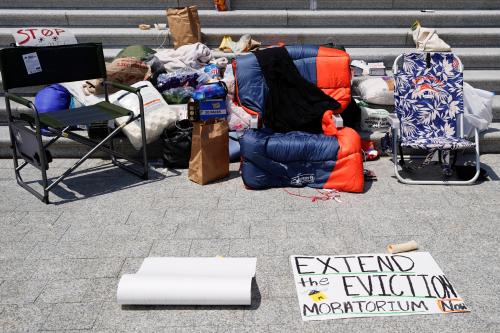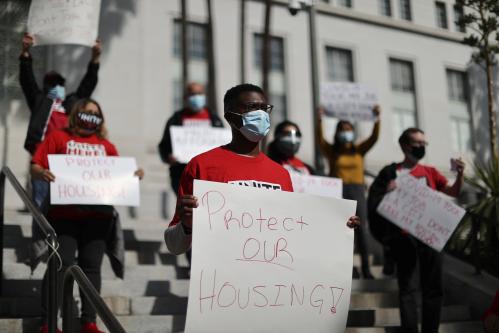Due to the pandemic-driven economic recession, the federal government has been forced to respond to the sharp rise in housing challenges Americans have faced. This federal intervention is a critical lifeline for millions of Americans who are in danger of losing their homes. However, states across the country have faced challenges in distributing those funds to their residents. Recent data from the Treasury Department shows that only about eleven percent of the $46.5 billion allocated by Congress has been spent. In large states like New York, one of the places having many challenges in distributing funds, there is the possibility of financial disaster given the high concentration of renters and high cost of living.
Drawing from a recent statewide survey of New Mexico adults (n=1,000) fielded from June 30 to July 18, 2021, we identify the series of obstacles to accessing federal funding to help residents’ housing situations. A collaboration between New Mexico Media Desk and BSP Research, the survey was designed to identify the challenges for residents to access funds, improve outreach efforts, and inform communications. It is our hope that some of the findings from the New Mexico study will help outreach efforts in other states and improve uptake of funding while time begins to run out on these funding streams.
Summary of the Challenges and Obstacles Facing State Residents
Overall, 20% (one in five) of New Mexicans reported having trouble making rent or mortgage payments, with 6% of the sample reporting that they are currently at risk of losing their housing through foreclosure or eviction. Families are, unfortunately, even more vulnerable. Respondents with children at home are twice as likely (13%) to report that they are at risk of losing their housing through foreclosure or eviction. Despite these challenges, only 16% of respondents reported receiving federal funding for mortgage or rental assistance.
One of the insights gained from the survey is that many state residents used their limited emergency funds to address housing needs, primarily to ensure they did not lose their homes. Thus, while 26% of New Mexicans facing economic stress said they could use financial assistance to support rent or mortgage payments, 23% need assistance with unpaid bills and debt payments to help ensure they can continue to pay for housing costs. This complicates using federal funds to help those in need, as the housing assistance funds are intended to pay landlords for rent or mortgage directly, limiting the ability to support other financial needs beyond housing.
Spreading knowledge of these resources is arguably the most prominent obstacle facing states. For example, half (50%) of New Mexicans have never heard of the rental assistance program that provides funds for up to 15 months of lease and utility payments. Furthermore, over half (54%) have never heard about the homeowner assistance program that provides funds for homeowners at risk of foreclosure due to the pandemic. As reflected in the figure below, basic knowledge of this program is significantly lower among Native American residents and those who chose to take the survey in Spanish.
Less than 20% of New Mexicans have heard enough about either program to apply for assistance. Evidence for the overall lack of awareness is reinforced by 36% of respondents—who have not received any assistance—reporting that they “did not know about this federal or state assistance until taking this survey.”
The survey reveals that there is a need for states to make the process more user-friendly. A little more than a third (35%) of respondents who are facing economic challenges without assistance reported that they “could not find a program after they heard about it.” Another 15% attempted to apply for funding unsuccessfully because the “process was too confusing or required information that they do not have.”
Recommendations for Increased Uptake of Resources
The survey was designed to provide actionable recommendations for both the state of New Mexico and the advocacy organizations conducting outreach to help the funding reach as many residents as possible. Below are some of the main recommendations gleaned from the survey that may be useful for other states.
- Provide multiple paths to apply for funding. Having a wide range of options available, beyond the internet, is recommended, as 15% report that applying through a paper application would be their preference. A sizable segment (11%) of New Mexicans do not have access to the internet at home or at work that would allow them to learn more about the assistance available to them and to apply for that funding online. Lack of internet access is higher among Native Americans in the state (17%), New Mexicans over the age of 60 (17%), and those making $20,000 or less annually in income (20%). While a large percentage (43%) of New Mexicans prefer to use their computer/laptop to apply for assistance, a similarly large percentage prefer to use a smartphone or tablet. Applications must be compatible with smartphones since they are the only high-speed internet source for many New Mexicans.
- Provide residents with technical assistance at all hours of the day. The City of San Antonio has reported high success with their 24-hour telephone support system, providing evidence that the provision of technical support increases overall uptake. A large percentage (29%) of respondents would like to apply by phone, speaking with a person who can assist with the process, and (29%) prefer in-person help from a state worker to fill out the application. Another 13% note that they would take advantage of personal assistance offered by an organization in their community to help fill out the application.
- States must address language barriers by providing translation support for non-English dominant residents and ensuring that the application is available in other languages. For example, 7% of New Mexicans (15% of Hispanic New Mexicans) indicate they prefer to submit their application in Spanish.
- Make clear that applying for funding will not impact immigration status. Overall, 21% of immigrants in New Mexico indicated that they did not apply for assistance because they were “concerned that accepting this assistance could complicate my immigration status with the government or that of a family member.” States must take steps to re-assure residents that their information will not be shared with immigration officials, and work with trusted community organizations to get that message out.
- Finally, and arguably most importantly, help residents understand how temporary funding may impact access to government supports they may already be using. The survey finds that many New Mexicans are not looking into housing assistance because they are worried about losing more long-term government support. Just over one in four (26%) of respondents who did not apply for assistance indicated they were “concerned that accepting assistance could jeopardize other benefits they receive.” Several other questions in the survey reinforced the perception among residents that if they have already received any COVID relief or are receiving other government assistance, they are not eligible for housing and other forms of assistance now. This is a significant obstacle that will undoubtedly limit the ability to get COVID-19 relief funding to eligible residents. It must be addressed and reassure residents that utilizing these funds will not impact more long-term assistance. This will require cooperation with the federal government and more in-depth research on how pandemic-driven temporary funding assistance may impact access to other types of assistance.
Although the survey is focused primarily on finding paths to connect more New Mexicans to the pandemic-driven temporary assistance, several findings suggest more states should implement permanent interventions. For instance, creating a more streamlined and user-friendly assistance system in the state. Survey respondents preferred that “there is one place or phone number to learn about and access all assistance programs.” Moreover, New Mexicans are appropriately worried about losing existing governmental assistance if they take advantage of the temporary assistance during the pandemic. Having a more precise picture available to Americans of how federal and state funding streams can be braided together to support themselves and their families, both during the pandemic and permanently, would be genuinely impactful if implemented across the country.
The Brookings Institution is committed to quality, independence, and impact.
We are supported by a diverse array of funders. In line with our values and policies, each Brookings publication represents the sole views of its author(s).








Commentary
States under time crunch to provide housing assistance: How to fix it
November 2, 2021